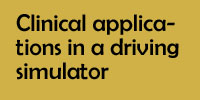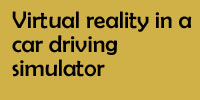In a VR system, a computer generated world is displayed by means of a helmet mounted display (HMD). A headtracker measures the position of the head and the direction the subject is looking at. The images are then presented to both eyes separately, from the viewpoint of the head in the direction the head is facing. Since images are presented to both eyes stereoscopically, the subject experiences depth which enhances the experience. Since the eyes are covered in most VR systems, the subject is unable to see the actual surroundings: only the virtual world is experienced and this greatly enhances immersion.
VR systems have been around since the seventies of the 20th century. The availability to the general public has been low because of the high cost and technical insufficiencies, for example, narrow field of view, inaccurate and slow headtracking that increases the lag between headmovements and graphical updates, and poor resolution. The more expensive systems are used in military training. However, the VR technology has not become popular in games or simulators. An important reason for that, apart from the cost, is the cybersickness that often occurs while using a HMD.
The Oculus Rift is the most recent development in VR that promises a larger field of view, high resolution, fast headtracking and less cybersickness for a very affordable price. It is tempting to use a quality low cost VR system like that in a driving simulator for driver training. It would reduce the cost of the simulator because a complex and expensive projection system is not required. You would have a very natural 3D vision with real stereoscopy. The experience of realism would be higher compare to regular driving simulators. Driver training in a VR simulator could potentially be more attractive for young learner drivers than traditional driver training because of the experience it can provide.
A regular driving simulator is similar to a Virtual Reality system, except for the helmet mounted displays (HMD’s) and head tracking. In both types of system, a computer generated world is presented to the driver and the driver interact with this world. In the case of a driving simulator, you drive through the computer generated world as if you are seated in a real car and you interact with other traffic participants and the road infrastructure in a very realistic but also safe way. A driving simulator is perfect for young inexperienced drivers. They hardly ever experience simulator sickness.
Simulator sickness is similar to the cybersickness experienced in VR systems, but it differs in some respects as well. Simulator sickness is very much related to the absense of motion which causes a mismatch between what you see and what you (expect to) feel. Since only experienced drivers have learned the experience of motions that occur, for example during lateral and longitudinal accelerations, they experience a mismatch between what they see and the lack of motions (in a fixed base simulator). This increases the risk of simulator sickness in older and more experienced drivers, while the risk is very low in young and inexperienced drivers. Simulator sickness also increases with higher immersion and with projections over a larger horizontal field of view. For example, a three-display (120 degrees horizontal field of view) simulator results in a higher incidence of simulator sickness compared to a simple one-display system. Also, a system with 180 degrees of larger projection screens gives a higher risk of simulator sickness compared to 23 inch monitors. In a regular driving simulator, the rendering of the graphics is static: on the left, middle and right displays the images are always from the perspective of the position of the head facing forward. So, to see what is left of you, you look to the left display. If you want to see what is in front of the car, you look at the middle display and if you want to look to the right, you check the right display. In other words, your ego reference is pretty much fixed. You sit in a virtual car and as the vehicle moves through the world, you move with it and your absolute position in the vehicle is fixed.
In a VR system this can be very confusing. There’s the motion of the vehicle which results in a different position and viewing direction in the virtual world, and there’s also the motion of the head which results in a different position and viewing direction in the virtual world. My point is that these two motions and directions are very difficulty to unravel by the brain in a VR system.
We have done tests with VR systems connected to the driving simulator, most recently with the Vuzix Wrap 1200VR, and we found consistently:
- driving in a VR system results in cybersickness very quickly, especially when you look around (left and right) while the car is driving. Especially the headaches can be quite pervasive.
- driving in a VR system is very hard, especially steering is difficult. For example, when you look to the left while you are driving, there’s a strong tendency, which is almost impossible to suppress, to steer to the left as well. So, your steering follows the direction your head turns and this is a persistent effect that makes driving difficult. It’s very difficult to stay in your lane or on the road.
Maybe these effects will not occur in a sophisticated system as the Oculus Rift. However, I doubt that, because the effects are so overwhelming.
Form my experience I would say that, for driving, the HMD as used in VR is not very well suited, because of the risk of cybersickness that comes with the use of HMD’s and because of the difficulty of the brain to separate the effects of vehicle movement and head movements:
- the vehicle moves through the world, controlled by the steering wheel and pedals of the driver.
- the driver looks around in the environment by turning the head (head tracking)
These two types of motions in combination give a high risk of cybersickness in a VR system and make steering very difficult. The brain is not very well able to distinguish these movements. It would be interesting to study these phenomena in more detail and to see if and how these problems can be solved. Maybe these effects are not so pervasive in a FPS game, where you ‘walk’ slowly and use other means to move forward (instead of a steering wheel and pedals). In the mean time, I seriously doubt if VR is suitable for driver training in a driving simulator.






